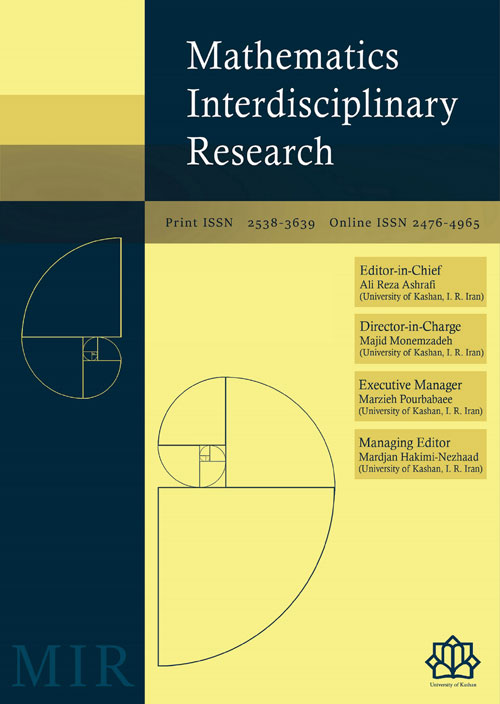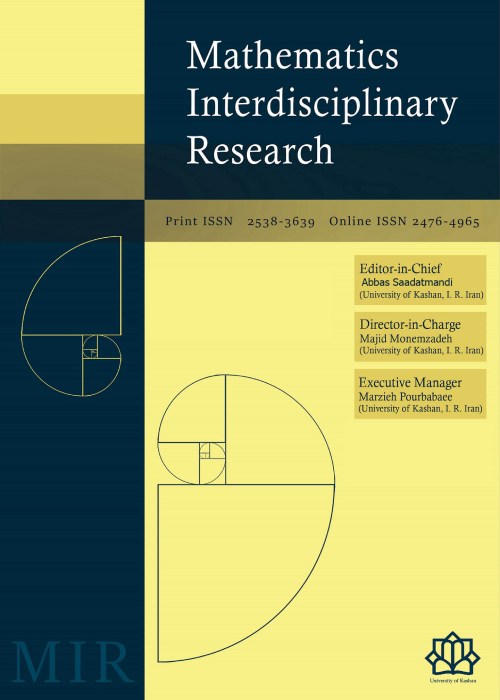فهرست مطالب

Mathematics Interdisciplinary Research
Volume:6 Issue: 1, Winter 2021
- تاریخ انتشار: 1400/06/18
- تعداد عناوین: 6
-
-
Pages 1-10For a simple graph G, the Gordon-Scantlebury index of G is equal to the number of paths of length two in G, and the Platt index is equal to the total sum of the degrees of all edges in G. In this paper, we study these indices in random plane-oriented recursive trees through a recurrence equation for the first Zagreb index. As n ∊ ∞, the asymptotic normality of these indices are given.Keywords: Gordon-Scantlebury index, Platt index, the first Zagreb index, plane-oriented recursive tree, asymptotic normality
-
Pages 11-22In this work, we develop the Sinc-collocation method coupled with a Double exponential transformation for solving a special class of nonlinear second-order multi-point boundary value problems (MBVP). This method attains a convergence rate of exponential order. Four numerical examples are also examined to demonstrate the efficiency and functionality of the newly proposed approach.Keywords: Double Exponential transformation, Collocation points, Multi-point boundary value problem, Sinc methods
-
Pages 23-33
In this paper, we introduce a subcategory Shf∗ of Sh∗ and obtain some results in this subcategory. First we show that there is a natural bijection Sh(Σ(X, x),(Y, y)) ∼= Sh((X, x), Sh((I, ˙I),(Y, y))), for every (Y, y) ∈ Shf∗ and (X, x) ∈ Sh∗. By this fact, we prove that for any pointed topological space (X, x) in Shf∗, πˇ top n (X, x) ∼= πˇ top n−k (Sh((S k , ∗),(X, x)), ex), for all 1 ≤ k ≤ n − 1.
* The formulas are not displayed correctly.
Keywords: Shape category, Topological shape homotopy group, Shape group, Suspensions -
Pages 35-61
We investigate Schwinger pair creation of charged scalar particles from a time-dependent electric field background in (1+3)-dimensional de Sitter spacetime. Since the field's equation of motion has no exact analytical solution, we employ emph{Olver's uniform asymptotic approximation method} to find its analytical approximate solutions. Depending on the value of the electric field $E$, and the particle's mass $m$, and wave vector $bfk$, the equation of motion has two turning points, whose different natures (real, complex, or double) lead to different pair production probability. More precisely, we find that for the turning points to be real and single, $m$ and $bfk$ should be small, and the more smaller are the easier to create the particles. On the other hand, when $m$ or $bfk$ is large enough, both turning points are complex, and the pair creation is exponentially suppressed. In addition, we study the pair creation in the weak electric field limit, and find that the semi-classical electric current responds as $E^{1-2sqrt{mu^2}}!left(1-ln Eright)$, where $mu^2=frac94-frac{mds^2}{H^2}$. Thus, below a critical mass $m_{mathrm{cr}}=sqrt{2} H$, the current exhibits the infrared hyperconductivity.
*The formulas are not displayed correctly.
Keywords: Schwinger mechanism, electromagnetic processes, time-dependent electric field, uniform asymptotic approximation -
Pages 63-83This paper introduces the concept of auto–Engel polygroups via the heart of hypergroups and investigates the relation between of auto–Engel polygroups and auto–nilpotent polygroups. Indeed, we show that the concept of heart of hypergroups plays an important role on construction of auto–Engel polygroups. This study considers the notation of characteristic set in hypergroups with respect to automorphism of hypergroups and shows that the heart of hypergroups is a characteristic set in hypergroups.Keywords: Auto–Engel polygroup, characteristic(-closure) set, general fundamental relation
-
Pages 85-95
In this paper, we introduce the concept of n-A-con-cos groups, n ≥ 2, mention some properties of them and determine all finite abelian groups with at most two direct factors. As a consequence, it is proved that dihedral groups D2m in which m has at most two prime factors are n-A-con-cos.
Keywords: n th−autocommutator subgroup, finite abelian groups, dihedral groups, n-A-con-cos groups


